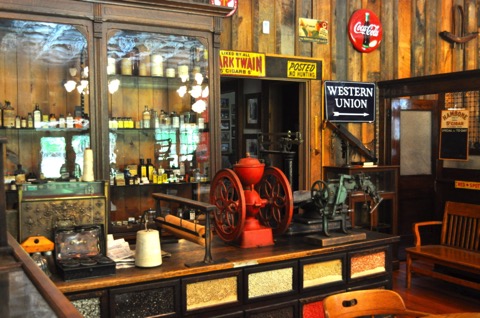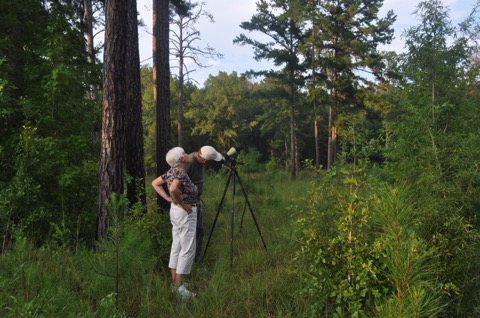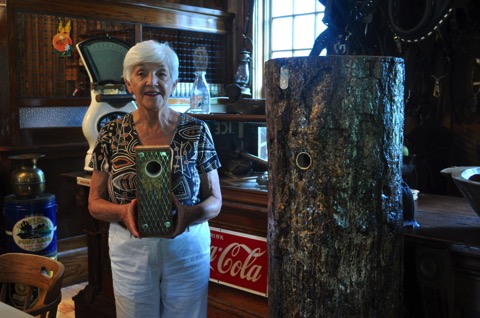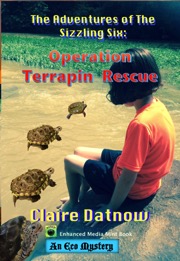YA Eco Mysteries, Memoirs, Novels & Travel
Writing Eco Mysteries 4
Just about 130 miles south east of Birmingham, we turn onto a narrow road, shaded by live oaks, leading to the Sehoy Plantation deep in the heart of Bullock County, Alabama. We have come to see Eric Spadgenske, with the U.S. Fish and Wildlife Service, and Mark Bailey, a conservation biologist, band two red-cockaded woodpeckers (RCW). As we pause to look around, we sense that we have fallen into another era rich in history. Across the road from a restored brick building that once served as a train depot and a general store, stands a gracious Southern plantation mansion.

Upon entering the plantation’s grounds, guests are greeted by a General Store with handsome wood flooring and cabinetry.
These structures and the surrounding forests and fields are part of the stew of history that has resulted in saving the Red-cockaded Woodpecker from extinction.
Seated at oak table inside the beautifully restored depot, which now serves as a conference room, Eric and Mark take time from their busy schedule to explain the work they are doing to save the RCW. Decades ago the forest now surrounding the plantation was cleared for the planting of crops. After the Civil War, the wealthy bought the property and came down from the North to escape the cold winters and enjoy hunting for game, deer, turkey, duck and especially quail. When the quail population declined in the early 1900s, the wildlife biologist Herbert L. Stoddard, fitted the pieces of a complex ecological mystery together. He understood that quail need open pinewoods where the sun pours down, but the woods were growing clogged with hardwood brush and thickets.

Open Forest Where RCW Roost
Stoddard astutely observed that fire started by lightening is key to keeping the forests open. Like a finger moving through a flame, fire stays close to the ground, removing brush and oak without reaching the green pine needles on limbs higher up, where the RCW build their nests. Using techniques that mimic nature, today controlled burns are started in on the plantation’s forests about every two years, leaving habitat not only suited to quails but also to the Red-cockaded Woodpecker.
But more scientific information had to be pieced together to save the RCW. In order to survive this particular woodpecker has some unique requirements. RCW is the only North American woodpecker that excavates cavities in living pines. They need trees that are at least 80 years old, because younger trees do not have old, soft heartwood free of sap in which the woodpecker can chip out a nest (this process can take several years), Unfortunately, most old longleaf forests have been cut down for timber and cotton production. In the mid-1800s, longleaf forests extended from Virginia to Florida to Texas and covered nearly 90 million acres. Today these forests covered just 3 percent of their original range. Without suitable nests the woodpecker was doomed to certain extinction. Could the RCW be saved?
Translocation of the RCW
At dawn on November 9, 2007, a historic event took place. Seven juvenile red-cockaded woodpeckers were moved form Fort Benning Ga., to the woods of Enon plantation (adjacent to Sehoy). Forty artificial cavities had been installed to provide a suitable habit for the new arrivals. These cavities were placed in younger loblolly pines, where the RCW will nest and breed. The rest is a success story. The transplanted woodpeckers have flourished and produced new generations of woodpeckers.

Artificial RCW nest inserted into the pine tree
We have been so entranced by the intriguing story of the Red-cockaded Woodpecker spun by Eric that we are surprised when he declares, “Time for us to go find the RCW in its habit!” To find out what we discovered visit Blog 5
For additional information visit these links:
The Red-cockaded Woodpecker on Sehoy and Enon Plantations
First-Ever RCW Translocation in Alabama
Red-cockaded Woodpecker and Hurricanes
Enon and Sehoy Plantations
A Bright Future for RCW
Birmingham Audubon Society


